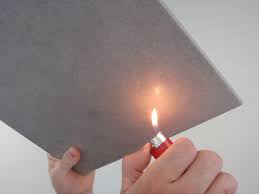Ceramic tiles are a popular choice for various applications. They are versatile flooring and wall covering materials made from clay and other natural materials. Also, they are kiln-fired at high temperatures, resulting in durable and water-resistant tiles available in various sizes, shapes, and finishes. But the common question remains is ceramic tile fireproof?
Ceramic tiles, though not entirely fireproof, possess commendable fire resistance due to their composition and kiln-firing process. Suitable for spaces exposed to heat, their effectiveness hinges on proper installation, making them a reliable choice for both aesthetics and fire safety.
Throughout this article, you’ll explore what make is ceramic tile fireproof and the performance of ceramic tiles in fire tests. To know more, read the article thoroughly.
What Make Is Ceramic Tile Fireproof:
These qualities make ceramic tiles a safe and reliable choice for various applications, including flooring, wall coverings, and fireplaces. Here’s a breakdown of what makes ceramic tiles fire-resistant.
#1- Natural Materials:
Ceramic tiles are primarily made from natural materials such as clay, sand, and other minerals. These materials are naturally fire-resistant and do not ignite or burn when exposed to flames.
#2- Kiln Firing:
During the manufacturing process, ceramic tiles are kiln-fired at extremely high temperatures ranging from 1800°F to 2500°F (1000°C to 1400°C). This intense heat causes the raw materials to undergo chemical changes, resulting in a dense and durable tile that is highly resistant to fire.
#3- Non-combustible Composition:
The combination of clay and minerals in ceramic tiles creates a non-combustible composition. Even when exposed to direct flame or high temperatures, ceramic tiles do not catch fire or contribute to the spread of flames.
#4- Absence Of Organic Materials:
Unlike some other building materials, ceramic tiles do not contain organic materials such as wood or plastics, which can fuel fires. This absence of combustible components further enhances the fireproof nature of ceramic tiles.
#5- Low Thermal Conductivity:
Ceramic tiles have low thermal conductivity, meaning they do not conduct heat easily. This property helps to prevent the transfer of heat from flames to adjacent materials, reducing the risk of fire spread.
#6- Chemical Stability:
Ceramic tiles exhibit high chemical stability, meaning they do not undergo significant chemical reactions when exposed to fire or high temperatures. This stability prevents the tiles from breaking down or releasing harmful substances when subjected to flames.
#7- Resistance To Thermal Shock:
Ceramic tiles are engineered to withstand sudden temperature changes, known as thermal shock. This resistance ensures that the tiles remain intact and structurally sound even when exposed to rapid heating or cooling, reducing the risk of cracking or breaking during a fire.
#8- Inorganic Glazes:
Many ceramic tiles are coated with inorganic glazes during the manufacturing process. These glazes are formulated using mineral-based compounds that enhance the tiles’ fire resistance and provide additional protection against heat and flames.
#9- Fire Rating Certifications:
Some ceramic tiles undergo testing and certification processes to determine their fire resistance rating. Tiles that meet specific industry standards for fire safety are labeled accordingly, assuring their fireproof qualities to consumers and builders.
#10- Application Versatility:
Ceramic tiles can be used in various fire-resistant construction applications, including flooring, wall cladding, and roof coverings. Their versatility allows them to contribute to overall fire safety measures in buildings by providing durable and fireproof surfaces in critical areas.
Performance Of Ceramic Tiles In Fire Tests:

The performance of ceramic tiles in fire tests is a critical aspect when evaluating their suitability for various applications. Ceramic tiles are often used in spaces where fire safety is a concern, such as kitchens, bathrooms, and around fireplaces. Here are key points to consider regarding the performance of ceramic tiles in fire tests:
1- Fire Resistance:
Ceramic tiles are known for their inherent fire resistance. When exposed to high temperatures, they do not combust, and their composition helps them withstand heat. The firing process during manufacturing contributes to their ability to resist damage from flames.
2- Heat Endurance:
Ceramic tiles exhibit good heat endurance, maintaining their structural integrity under elevated temperatures. This quality is crucial, especially in areas with potential heat sources such as stovetops or fireplaces.
3- Resistance To Thermal Shock:
Ceramic tiles are designed to resist thermal shock, which occurs when a material undergoes rapid temperature changes. This resistance is important in situations where tiles might be exposed to sudden and extreme temperature variations.
4- Crack Prevention:
While ceramic tiles are generally resilient to heat, rapid and extreme temperature changes can lead to cracking. Proper installation, along with the selection of appropriate tiles for specific applications, is crucial to prevent potential issues.
5- Grout and Adhesive Considerations:
It’s essential to consider not only the ceramic tiles themselves but also the grout and adhesive used during installation. These components may have different heat resistance properties, and their contribution to the overall fire performance should be taken into account.
6- Industry Standards:
Various industry standards and certifications exist for evaluating the fire performance of building materials, including ceramic tiles. Compliance with these standards ensures that the tiles meet specific criteria for fire resistance and safety.
Related Question:

Will Ceramic Tile Crack Under Heat?
Ceramic tiles are resistant to cracking under heat, but extreme and rapid temperature changes can cause thermal stress, leading to potential cracks. Proper installation and choosing tiles with suitable heat resistance are essential to minimize the risk.
It’s crucial to follow the recommended guidelines for preventing thermal shock and ensuring the longevity of ceramic tiles.
What Kind Of Tile Is Best Around A Fireplace?
Porcelain tiles are an excellent choice around a fireplace due to their high durability, heat resistance, and low water absorption. Their dense composition makes them less prone to cracking under temperature variations.
Glazed porcelain tiles offer aesthetic versatility, providing a stylish and functional solution for fireplace surrounds and hearths.
Can You Use Ceramic Tile Behind A Wood Stove?
Using ceramic tiles behind a wood stove is feasible and practical. Ceramic tiles are heat-resistant and can withstand the elevated temperatures generated by a wood stove. Ensure proper installation, including adequate spacing and use of suitable adhesive.
This provides both a protective and visually appealing solution for the area behind a wood stove.
Can You Use Ceramic Tiles Behind A Log Burner?
Ceramic tiles are suitable for use behind a log burner. With their heat resistance, they can withstand the high temperatures produced by the burner. Proper installation, considering spacing and appropriate adhesive, ensures a safe and durable surface.
Ceramic tiles offer both functionality and an attractive backdrop for a log burner.
Can You Put A Wood Stove On Ceramic Tile?
You can place a wood stove on ceramic tile. Ceramic tiles are heat-resistant and provide a suitable surface for supporting the weight and heat produced by a wood stove.
Ensure proper installation with a heat-resistant substrate, and use a non-combustible base to enhance safety and protect the surrounding area.
How Much Heat Can Ceramic Tile Withstand?
Ceramic tiles can withstand high temperatures, typically up to 2000 degrees Fahrenheit (1093 degrees Celsius). This exceptional heat resistance makes them a reliable choice for surfaces near sources of heat, such as fireplaces and stovetops.
Their non-combustible nature ensures they remain structurally intact, providing both safety and durability in environments with elevated temperatures.
Conclusion:
In conclusion, ceramic tiles are a versatile and resilient choice for areas exposed to heat sources like fireplaces, wood stoves, or log burners. Their heat resistance, durability, and aesthetic options make them ideal for creating both safe and visually appealing environments. Proper installation and adherence to safety guidelines ensure the longevity and effectiveness of ceramic tiles in these applications.


